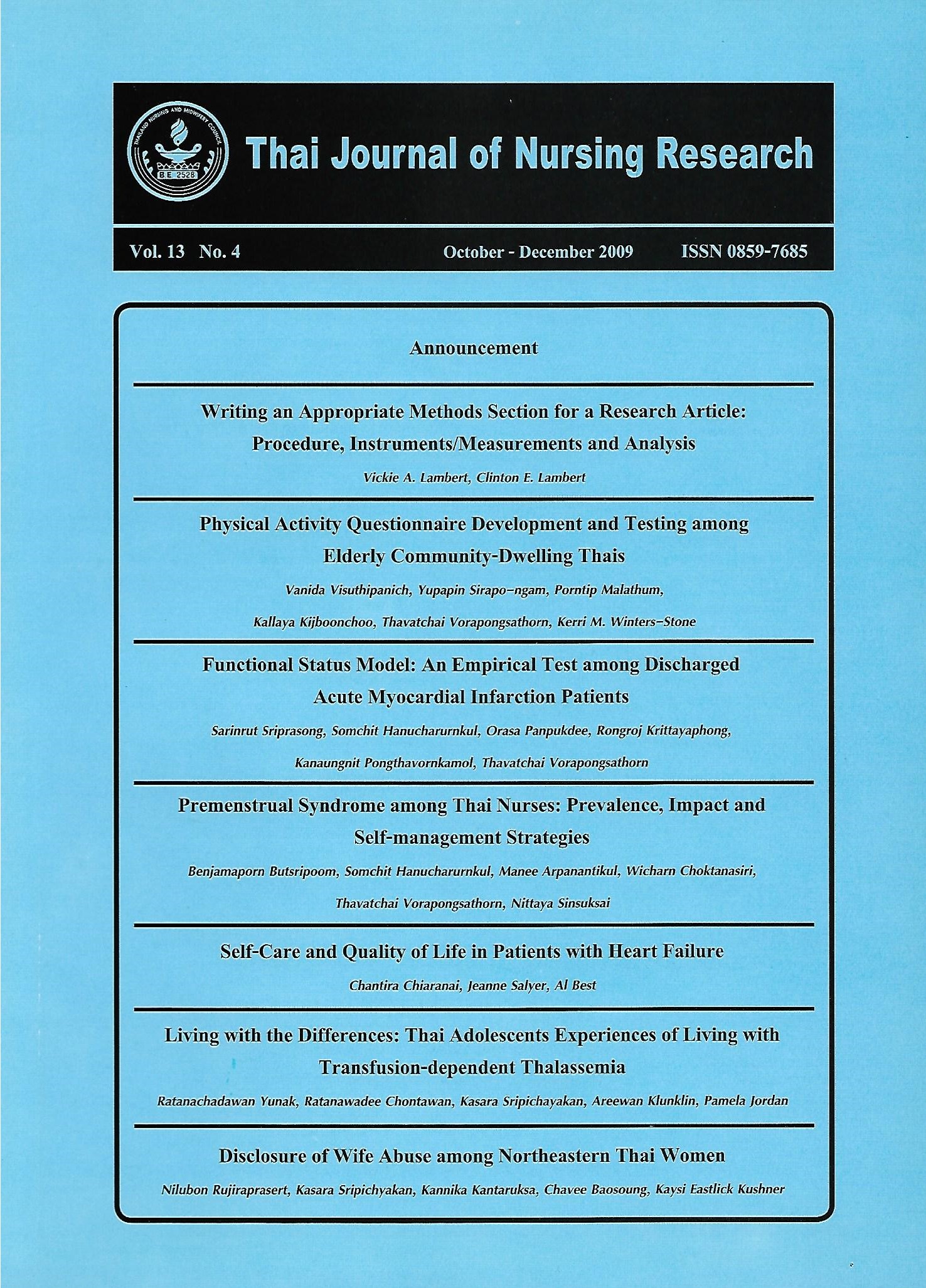Disclosure of Wife Abuse among Northeastern Thai Women
Keywords:
การปกปิด, การเปิดเผยข้อมูล, การทารุณกรรมภรรยา, วิธีวิจัยโดยใช้แนวคิดเชิงสตรีนิยมร่วมกับการสร้างทฤษฎีจากข้อมูล, สตรีไทยภาคตะวันออกเฉียงเหนือ, concealment, disclosure, feminist grounded theory, Northeastern Thai women, wife abuseAbstract
บทคัดย่อ
การศึกษาโดยใช้แนวคิดเชิงสตรีนิยมกับวิธีวิจัยแบบการสร้างทฤษฎีจากข้อมูลครั้งนี้สตรีไทยในภาคตะวันออกเฉียงเหนือที่ถูกสามีทารุณกรรมจำนวน 16 คนได้รับการสัมภาษณ์ที่เน้นการสะท้อนคิดและความสัมพันธ์เชิงอำนาจที่เท่าเทียมกัน จากวิธีการวิเคราะห์เปรียบเทียบพบว่า การเคลื่อนสู่การเปิดเผยเพื่อความอยู่รอด เป็นกระบวนการที่เกิดขึ้นโดยสตรีปกปิดการถูกสามีทารุณกรรม เพื่อการอยู่รอดจากการถูกซ้ำเติม และต่อมาเปิดเผยเพื่อการอยู่รอดจากสถานการณ์คับขัน ภายใต้อคติเกี่ยวกับการทารุณกรรมภรรยาในสังคมไทย สตรีปกปิดการถูกสามีทารุณกรรมโดยการปกปิดร่องรอย การแยกตัว การเงียบ หรือการแต่งเรื่องใหม่เพื่อปกป้องความเป็นตัวตนและความปลอดภัยของตนเอง รักษาภาพลักษณ์ของสามี หรือความผาสุกของครอบครัว แม้ว่าสตรีรู้สึกอัดอั้น กลัว หรือมีอาการแสดงทางร่างกายจากการปกปิดความลับ เมื่อการทารุณกรรมยังดำเนินต่อไปและรุนแรงขึ้น สตรีจะเคลื่อนเข้าสู่การเปิดเผยเรื่องราวของตนเองโดยการจำต้องยอมรับ การเปรยเพื่อหยั่งเชิง การเล่า หรือการแลกเปลี่ยนเรื่องราวเพื่อเป็นการระบาย การแสวงหาความช่วยเหลือ การก้าวผ่านจุดที่ทนไม่ไหว หรือการหลุดพ้นจากการถูกทารุณกรรม การตัดสินใจเกี่ยวกับการเปิดเผยการถูกสามีทารุณกรรมยังได้รับอิทธิพลจากมายาคติเกี่ยวกับการทารุณกรรมภรรยา ลักษณะและการตอบสนองของผู้ฟัง ตลอดจนลักษณะการถูกทารุณกรรม ภายหลังเปิดเผยสตรีบางคนได้รับผลจากการเปิดเผยการถูกสามีทารุณกรรมในด้านลบ ซึ่งได้แก่ความรู้สึกอาย รู้สึกผิด ถูกตำหนิซ้ำเติม รวมทั้งถูกนินทา ขณะที่สตรีบางคนได้รับผลจากการเปิดเผยในด้านบวกได้แก่ความรู้สึกได้ปลดปล่อย เพิ่มความรู้สึกมีคุณค่าและได้รับความช่วยเหลือ ผลการศึกษาครั้งนี้ช่วยให้เข้าใจอย่างถ่องแท้ว่าสตรีที่ถูกทารุณกรรมมิได้นิ่งเฉยแต่มีศักยภาพในการอยู่รอดโดยการปกปิดหรือการเปิดเผยการถูกทารุณกรรม การเข้าหาสตรีเหล่านี้ด้วยท่าทีที่ยอมรับนับถือและไม่ซ้ำเติมจึงเป็นก้าวแรกที่จะเสริมสร้างพลังอำนาจแก่สตรีในการเรียกร้องความช่วยเหลือ และการเข้าถึงบริการ
คำสำคัญ: การปกปิด, การเปิดเผยข้อมูล, การทารุณกรรมภรรยา, วิธีวิจัยโดยใช้แนวคิดเชิงสตรีนิยมร่วมกับการสร้างทฤษฎีจากข้อมูล, สตรีไทยภาคตะวันออกเฉียงเหนือ
Abstract
In this feminist grounded theory study, sixteen Northeastern Thai women with wife abuse experiences were interviewed with reflexive discussion and a balanced power relationship. Through the constant comparative method, “Moving to Disclosure for Survival” emerged as the process by which the women concealed the abuse to survive revictimization and then disclosed to survive critical circumstances. Under prejudice regarding wife abuse in Thai society, the women concealed their abuse by: covering, isolating, silencing or revising, in order to protect their sense of self and safety, and their husbands’ image or family well-being in spite of repression, fear or psychosomatic symptoms resulting from keeping a secret. As the abuse continued and escalated, the women moved to reveal their stories by yielding, hinting, telling or sharing to release tension, seeking support, getting through the unbearable point or being free from abuse. The women’s decisions about disclosure also were influenced by wife abuse myths, confidants’ attributes and responses and abuse characteristics. Following disclosure, some women had negative experiences, including shame and guilt, as well as being blamed, revictimized and/or gossiped about. Positively, some of the women felt relieved, had increased self-worth and obtained support.
The findings provide authentic understanding that abused women are not passive, but capable of surviving by concealing or disclosing. Approaching the women with a respectful and non-revictimizing manner is an initial step in empowering them to raise their voice for further assistance and service accessibility.
Keywords: concealment, disclosure, feminist grounded theory, Northeastern Thai women; wife abuse
Downloads
How to Cite
Issue
Section
License
Copyright: The Pacific Rim International Journal of Nursing Research, Thailand Nursing & Midwifery Council has exclusive rights to publish, reproduce and distribute the manuscript and all contents therein.








.png)



